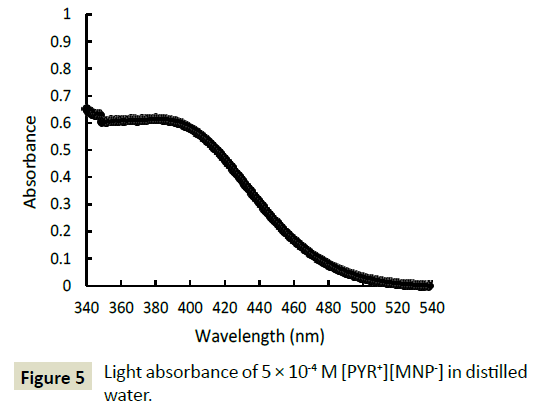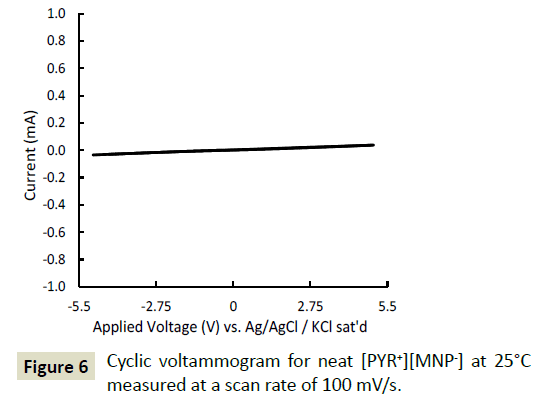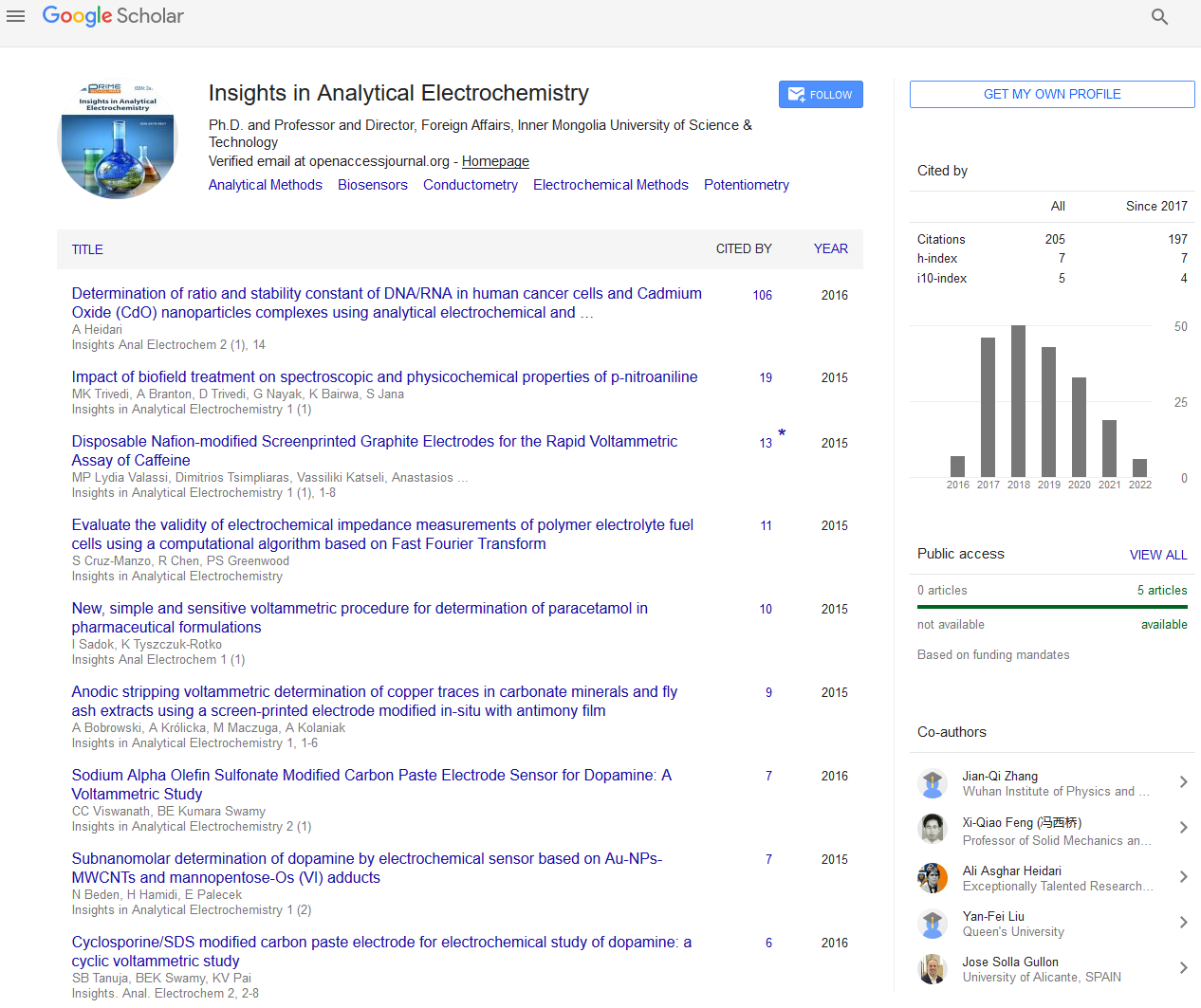Richard D Pettipas1,Zahid S Mahimwalla1,Michel B Johnson2 andKhashayar Ghandi1*
1Department of Chemistry and Biochemistry, Mount Allison University, Sackville, New Brunswick E4L 1G8, Canada
2Department of Chemistry, Dalhousie University, Halifax, NS B3H 4J3, Canada
- *Corresponding Author:
- Khashayar Ghandi
Department of Chemistry and Biochemistry, Mount Allison University, Sackville, New Brunswick E4L 1G8, Canada
E-mail:kghandi@mta.ca
Received date: March 28, 2016; Accepted date: April 15, 2016; Published date: April 23, 2016
Citation: Pettipas RD, Mahimwalla ZS, Johnson MB, et al. Iconicity and Electrochemical Properties of Visible Light Absorbing Pyrrolidinium M-Nitrophenolate. Insights Anal Electrochem. 2016, 2:1 doi:10.21767/2470-9867.100012
Keywords
Ionic liquid; Protic ionic liquid; Dye; Electrolyte; Solvent; Ion conductivity; Viscosity; Light absorbance; Walden plot; Dye sensitized solar cell
Abbreviations
DSC: Differential Scanning Calorimetry; PIL: Protic Ionic Liquid; RTIL: Room Temperature Ionic Liquid; UV: Ultra Violet; NMR: Nuclear Magnetic Resonance; DSSC: Dye Sensitized Solar Cell
Introduction
Ionic liquids are a class of molten salts which have a melting point below 100°C [1]. The characteristic high thermal stability [2,3], low volatility [4], high ionic conductivity [4] and low flammability of ionic liquids has attracted interest in in their use as electrolytes and solvents which can also serve as catalysts [5]. In particular ionic liquids with melting points below 100°C commonly referred to as a room temperature ionic liquids (RTIL’s) have attracted interest as green solvents and electrolytes due to their liquid state at room temperature [6]. Protic ionic liquids (PILs) are a type of ionic liquid synthesized by the transfer of a proton from an acid to a base forming a permanently charged anion (A-) and a protonated cation (HB+) [5].
HA+B ÃÆÃâÃââÃÆââ¬Å¡Ã¢ââ¬Ã¡ÃÆââ¬Å¡Ãâ¦Ã¢â¬â¢A-+HB+ (1)
This reversible reaction is driven by the difference in ΔpKa values between the acid and base. There has been a great deal of discussion on a described ΔpKa threshold that must be overcome in order to obtain good ionic liquid behavior with the previously mentioned characteristic properties [7-16]. Some propose that a ΔpKa separation of 8 [9] or higher [7,10] is needed, while others have shown that a ΔpKa separation of 4 is sufficient to obtain 99.9% proton transfer [12,13]. Strong Bronsted bases such as ammonia [17], pyrrolidine [18], guanidine [19] and imidazole [20] are commonly used in combination with strong acids such as nitric acid [21], sulfuric acid [22] and acetic acid [23] to drive the equilibrium of equation 1 further to the right. Many well-known protic ionic liquids are made by maximizing the ΔpKa separation between the acid and the base however this drastically limits the available cations and anions that are considered usable in the synthesis PIL’s. When this limitation is removed new protic ionic liquids can be synthesized which incorporate weakly acidic dyes. Incorporating such dyes into the protic ionic liquid structure can introduce optical properties such as visible light absorption into these electrolytes. Recent studies have investigated the optical properties of aprotic ionic liquids. However, from a green chemistry perspective aprotic ionic liquid synthesis exhibits low atom economy due to the involved generation of waste products, solvent use and purification procedures [24-31]. The combined optical and electrochemical properties of these materials could lead to new avenues in the development of sensing materials and new directions in the field of photovoltaics. Here we seek to address an issue with dye sensitized solar cell (DSSC) devices regarding the absorption of ultraviolet (UV) light by TiO2 resulting in efficiency losses and also the depletion of I3 - in theI3 -/I- redox couple following absorption of <500 nm [32,33] These devices are typically shielded from this light using an UV filter, here we seek to develop an electrolyte which absorbs ultraviolet and visible light by incorporating a chromophore into the protic ionic liquid structure. The chromophore can be introduced by deprotonating a weakly acidic pH sensitive dye using a Bronsted base to induce a bathochromic shift allowing absorption of UV-Vis light while retaining the characteristic ion transport properties of protic ionic liquids. Our investigation involves the use of m-nitrophenol, a weakly acidic dye which absorbs UV and visible light to undergo an intramolecular charge transfer [34-36]. To deprotonate m-nitrophenol we have selected the strong base pyrrolidine, previously shown to generate PILs with favorable ion transport properties [18,37].
Materials and Methods
Materials
m-Nitrophenol ≥ 99% and pyrrolidine ≥ 99% were purchased from Sigma Aldrich and used as received.
Synthesis of pyrrolidinium m-nitrophenolate
m-Nitrophenol (1 g, 7.2 mmol) was added to pyrrolidine (0.6 mL, 7.2 mmol) in a 20 mL reaction vessel. Contents were stirred at 50°C for 30 minutes under solvent free conditions to obtain a viscous red liquid at ≥ 99% yield. 1H NMR (200 MHz, D2O) δ 7.36- 6.98 (3H, m), δ 6.80 (1H, d), δ 3.10-2.95 (4H, m), δ 1.26-1.17 (4H, m). ATR-FTIR (neat, cm-1): 2971, 2416, 1866, 1599, 1510, 1456, 1345, 1301, 1267, 1241, 1076, 989, 934, 864, 813, 789, 736, 672 cm-1.
Structural characterization
1H NMR spectra were recorded on a 200 MHz Varian MercuryPlus. FTIR spectra were recorded on a Thermo Scientific Nicolet iS5 FTInfrared spectrometer with an iD5 ATR Diamond accessory.
Physical characterization
Ionic Conductivity was recorded using a SUNTEX Conductivity Meter-SC170 with a cell constant of 1 cm calibrated using 0.01M KCl. Ionic conductivity measurements were taken at 2°C intervals in a calibrated reaction vessel while increasing the temperature of the oil bath in which the reaction vessel was immersed. Viscosity was measured using a BrookField-LV viscometer in a calibrated reaction vessel, heated by immersion in an oil bath. The oil bath was gradually heated and the temperature of sample and reaction vessel calibrated in relation to the oil bath temperature. Mass and volume measurements were determined using an analytical balance and a graduated cylinder at room temperature.
Light absorbance
UV/Vis spectra were recorded in a 1 cm quartz cuvette using a Varian Cary 100 Bio UV-Vis spectrometer.
Cyclic voltammetry
Scans were conducted using a Biologic SP-150 potentiostat using EC LAB software. A standard three electrode system was used consisting of a platinum wire counter electrode (BASi MW-4130), a reference electrode, composed of a Ag/AgCl wire (BASi, MF- 2052) in 3 M NaCl solution and a glassy carbon working electrode (BASi, MF-2015) filled with carbon paste (BASi, CF-1010). All measurements were conducted under atmospheric conditions.
Thermal phase behavior
Differential scanning calorimetry was performed using 11.85 mg of the sample into a tared hermetic aluminum sample pan. The pan and lid were hermetically sealed and the sample was loaded into a TA instruments Q200 differential scanning calorimeter for measurement. Measurements were performed under a helium atmosphere (25 mL min-1 flow rate) using the liquid nitrogen cooling accessory as the cooling unit. The cell is first calibrated with indium as standard reference material (Tmelt=156.6°C and ΔHfus=28.71 J g-1) and with mercury as a second temperature standard (Tmelt=-38.8°C). The sample was equilibrate at -150°C, held for 5 minutes and then heated at a ramp rate of 10°C min- 1 to 130°C and held at that temperature for one minute before cooling at a ramp rate of 10°C min-1 to -150°C.
Results and Discussion
We first synthesized pyrrolidinium m-nitrophenolate [PYR+] [MNP-] by the proton transfer from pyrrolidine to m-nitrophenol at a mild reaction temperature in the absence of a solvent as shown in Scheme 1. NMR and Attenuated Total Reflectance Fourier Transform Infrared Spectroscopy (ATR-FTIR) show that the reaction went to completion with no side products formed. This process was determined to be thermodynamically favorable according to equation 2 where the theoretical Gibbs free energy value is equal to -17.1 kJ/mol [9].
Scheme 1: Reaction of pyrrolidine (PYR) with m-nitrophenol (MNP) to give the product, pyrrolidinium m-nitrophenolate([PYR+][MNP-]) [38,39].
ΔG0=-2.303RTΔpKa (2)
The thermal phase behavior of [PYR+][MNP-] was investigated to predict the range of potential applications and experiments that could be performed. The thermal phase transitions were investigated using Differential Scanning Calorimetry (DSC) as shown in Figure 1.
Figure 1: DSC thermogram of [PYR+][MNP-] over one complete heating and cooling cycle, positive heat flow indicatesn exothermic process.
In Figure 1 it can be seen that [PYR+][MNP-] remains in the liquid state until cooled to -44°C. Further cooling resulted in organization of the glass as evidenced by the exothermic peak at -107°C. It can be implied from Figure 1 that [PYR+][MNP-] is thermally stable to at least 100°C allowing a higher temperature investigation of the transport properties. The low ΔpKa separation between m-nitrophenol and pyrrolidinium goes against conventional recommendations of large ΔpKa separation and might suggest the possibility of incomplete proton transfer. To further investigate the degree of proton transfer using a Walden plot, which requires knowledge of the density, viscosity and ion conductivity of the ionic liquid was created. We first investigated the viscosity of [PYR+][MNP-], a graph illustrating the change in viscosity as a function of temperature is shown in Figure 2.
In Figure 2 the expected decrease in viscosity with increasing temperature can be seen through temperature dependent viscosity measurements. The PIL is a viscous liquid at 25°C (1.26 Pa.s) becoming considerably more fluid with increasing temperature. Conventional knowledge of protic ionic liquids would suggest that a low ΔpKa separation would result in poor ion conductivity, however we find that the ion conductivity of [PYR+][MNP-] shown in Figure 3 compares well to that of typical protic ionic liquids with much greater ΔpKa separations [40].
Figure 2: Viscosity of [PYR+][MNP-].
Figure 3: Ion Conductivity of neat [PYR+][MNP-] in comparison to [MTBDH+][TFE-] (Δpka= 12.9), [MTBDH+][TFE-] (Δpka=10.9) and [MTBDH+] [PhO-] (Δpka=15.4) [40,41]. The solid line is used as a guide for the eye.
As shown in Figure 3, the ion conductivity of 3 increases from 0.381 mS/cm at 25°C to 8.29 mS/cm at 92°C illustrating moderate to high ion conductivity. Using this information we can compare the degree of proton transfer of [PYR+][MNP-]to that of ideal 0.01M KCl for which complete ionization is said to occur, the comparison is shown in Figure 4 using a Walden Plot [42].
Figure 4: Walden plot of [PYR+][MNP-], the solid line indicates ideal 0.01 M KCl behavior [42]. The solid line serves to guide the eye.
In Figure 4 we find that[PYR+][MNP-]demonstrates good ionic liquid behavior approaching that of ideal 0.01M KCl indicating nearly complete proton transfer and ionization. The degree of proton transfer can be calculated using equation 3 to predict 99.9% proton transfer at a ΔpKa separation of 3.3 [13].
 (3)
(3)
These results suggest that even weak acids could be used in protic ionic liquid synthesis. With almost complete proton transfer we investigated the optical properties of [PYR+][MNP-] by studying the wavelengths of light absorbed in the UV/Vis region as shown in Figure 5.
Figure 5: Light absorbance of 5 × 10-4 M [PYR+][MNP-] in distilled water.
In Figure 5 a maximum absorbance of 3 is obtained at 382 nm (ε=1.23 × 103 L mol-1cm-1) which persists beyond 400 nm (ε=1.14 × 103 L mol-1cm-1) into the visible region. Absorption of light in this range is beneficial as it allows [PYR+][MNP-] to absorb light which would otherwise harm dye sensitized solar cell components in addition to facilitating ion transport as an electrolyte. Application of this material in such devices requires an investigation into the electrochemical stability. We investigated the electrochemical stability using cyclic voltammetry over the range of -5 to 5 V in reference to a Ag/AgCl reference electrode, the results of this investigation are shown in Figure 6.
Figure 6: Cyclic voltammogram for neat [PYR+][MNP-] at 25°C measured at a scan rate of 100 mV/s.
In Figure 6 we see no evidence of oxidation or reduction over an electrochemical window of 10 V indicating remarkable electrochemical stability. This finding suggests that [PYR+][MNP-] is well suited towards photovoltaic applications however further study is needed to determine the stability of the electrolyte over time. Further study is required in order to establish the performance of this material as an electrolyte and its potential to function as a sensitizer in photovoltaic applications.
Conclusion
We have shown that complete proton transfer can be obtained at a ΔpKa separation of 3.31 indicating that weak acid and base combinations may be used in protic ionic liquid synthesis. We also report a green synthetic technique to generate a liquid dye capable of absorbing ultraviolet and visible wavelengths of light by using a pH sensitive dye as the anion. We find that the electrochemical window of [PYR+][MNP-] is in excess of 10 V suggesting it can be used in applications such as dye sensitized solar cells among other electrochemical devices.
Acknowledgements
Synthetic and experimental work was supported by Natural Sciences and Engineering Research Council, NBIF and H.E Bigelow Fund. We acknowledge the support of the Canada Foundation for Innovation, the Atlantic Innovation Fund, and other partners which fund the Facilities for Materials Characterization, managed by the Institute for Research in Materials.
References
- Welton T (1999) Room-Temperature Ionic Liquids. Solvents for Synthesis and Catalysis. Chem Rev 99: 2071-2084.
- Sharma G, Singh V, Gardas RL (2015) Apparent molar properties of aqueous protic ionic liquid solutions at T=(293.15 to 328.15) K. Ionics (Kiel) 21:1-7.
- Singh D, Singh V, Gardas RL (2015) Volumetric and Acoustic Properties of a DBU (1,8-Diazobicyclo[5.4.0]undec-7-ene) Based Protic Ionic Liquid in Water at T=(293.15 to 328.15) K. J Solution Chem 44: 1-18.
- Anouti M, Timperman L(2013) A pyrrolidinium nitrate protic ionic liquid-based electrolyte for very low-temperature electrical double-layer capacitors. PhysChemChemPhys 15:6539-6548.
- Greaves TL, Drummond CJ (2008) Protic ionic liquids: properties and applications. Chem Rev 108: 206-237.
- Ghandi K (2014) A Review of Ionic Liquids, Their Limits and Applications. Green Sustain Chem4: 44-53.
- Yoshizawa M, Xu W, Angell CA (2003) Ionic liquids by proton transfer: vapor pressure, conductivity, and the relevance of DeltapKa from aqueous solutions. J Am ChemSoc 125: 15411-15419.
- Canongia Lopes JN, Rebelo LP (2010) Ionic liquids and reactive azeotropes: the continuity of the aprotic and protic classes. PhysChemChemPhys 12: 1948-1952.
- Belieres JP, Angell CA (2007) Protic Ionic Liquids: Preparation, Characterization, and Proton Free Energy Level Representation. J PhysChem B 111:4926-4937.
- Bautista-Martinez JA, Tang L, Belieres JP, Zeller R, Angell CA, et al. (2009) Hydrogen Redox in Protic Ionic Liquids and a Direct Measurement of Proton Thermodynamics. J PhysChem C 113: 12586-12593.
- MacFarlane DR, Seddon KR (2007) Ionic Liquids-Progress on the Fundamental Issues. Aust J Chem 60:3-5.
- Stoimenovski J, Izgorodina EI, MacFarlane DR (2010) Ionicity and proton transfer in protic ionic liquids. PhysChemChemPhys 12: 10341-10347.
- MacFarlane DR, Pringle JM, Johansson KM, Forsyth SA, Forsyth M (2006) Lewis base ionic liquids. ChemCommun (Camb),pp: 1905-1917.
- Johansson KM, Izgorodina EI, Forsyth M, MacFarlane DR, Seddon KR (2008) Protic ionic liquids based on the dimeric and oligomeric anions: [(AcO)xH(x-1)]-. PhysChemChemPhys 10: 2972-2978.
- Banerjee R, Bhatt PM, Ravindra NV, Desiraju GR (2005) Saccharin salts of active pharmaceutical ingredients, their crystal structures, and increased watersolubilities. Cryst Growth Des 5:2299-2309.
- Nuthakki B, Greaves TL, Krodkiewska I (2007) Protic Ionic Liquids and Ionicity. Aust J Chem 60.
- Zabielska-Matejuk J, Stangierska A, Kot M (2015) New Ammonium- and 1,2,4-Triazolium-Based Ionic Liquids for Wood Preservation. J Wood Chem Technol. 35:178-192.
- Anouti M, Caillon-Caravanier M, Dridi Y, Galiano H, Lemordant D(2008) Synthesis and Characterization of New Pyrrolidinium Based Protic Ionic Liquids. Good and Superionic Liquids. J PhysChem B 112:13335-13343.
- Domanska U, Królikowski M, Acree Jr. WE, Baker GA (2013) Physicochemical properties and activity coefficients at infinite dilution for organic solutes and water in a novel bicyclic guanidiniumsuperbase-derived protic ionic liquid. J ChemThermodyn 58:62-69.
- Pernak J, Sobaszkiewicz K, Foksowicz-Flaczyk J(2004) Ionic Liquids with Symmetrical Dialkoxymethyl-Substituted ImidazoliumCations. Chemistry 10:3479-3485.
- Uebe die Molekulargrosse und elektrischeLeifahigkeiteinigergesehmolzenenSalze(1914) Bull L’Academie Imp des Sci St-petersbg 8:405-422.
- Nazari S, Cameron S, Johnson MB, Ghandi K(2013) Physicochemical properties of imidazo-pyridine protic ionic liquids. J Mater Chem A 1: 11570-11579.
- Wang C, Guo L, Li H, Wang Y, Weng J, et al. (2006) Preparation of simple ammonium ionic liquids and their application in the cracking of dialkoxypropanes. Green Chem 8:603-607.
- Delgado JM, Raymundo A, Vilarigues M, Branco LC, Laia CA (2015) Characterization of a novel intrinsic luminescent room-temperature ionic liquid based on [P6,6,6,14][ANS]. Chemistry 21: 726-732.
- Fiorani G, Selva M, Perosa A, et al. (2015) Luminescent dansyl-based ionic liquids from amino acids and methylcarbonateonium salt precursors: synthesis and photobehaviour. Green Chem 17:538-550.
- Olivier JH, Camerel F, Barberá J, Retailleau P, Ziessel R (2009) Ionic liquid crystals formed by self-assembly around an anionic anthracene core. Chemistry 15: 8163-8174.
- Zhang Q, Yang B, Zhang S, Liu S, Deng Y (2011) Ionic liquidized-naphthalenesulfonamide: successful fabrication of liquid fluorescent materials. J Mater Chem. 21:16335-16338.
- Jo TS, McCurdy WL, Tanthmanatham O, et al.(2012) Synthesis and characterization of luminescent tricationic salts of mesitylene and stilbazolium moieties. J MolStruct1019:174-182.
- Campbell PS, Yang M, Pitz D, Cybinska J, Mudring AV (2014) Highly Luminescent and Color-Tunable Salicylate Ionic Liquids. ChemA Eur J 20:4704-4712.
- Godajdar BM, Kiasat AR, Hashemi MM (2013) Synthesis, characterization and application of magnetic room temperature dicationic ionic liquid as an efficient catalyst for the preparation of 1,2-azidoalcohols. J MolLiq 183:14-19.
- Boschloo G, Hagfeldt A (2009) Characteristics of the iodide/triiodide redox mediator in dye-sensitized solar cells. AccChem Res 42: 1819-1826.
- Boschloo G, Gibson EA, Hagfeldt A(2011) Photomodulated Voltammetry of Iodide/Triiodide Redox Electrolytes and Its Relevance to Dye-Sensitized Solar Cells. J Phys Chem Lett. 2:3016-3020.
- Grabowski ZR, Rotkiewicz K, Rettig W (2003) Structural Changes Accompanying Intramolecular Electron Transfer: Focus on Twisted Intramolecular Charge-Transfer States and Structures. Chem Rev 103:3899-4032.
- Wanko M, Houmøller J, Støchkel K, et al.(2012) Substitution effects on the absorption spectra of nitrophenolate isomers. PhysChemChem Phys. 14:12905-12911.
- Houmøller J, Wanko M, Støchkel K, Rubio A, Brøndsted Nielsen S, et al. (2013) On the Effect of a Single Solvent Molecule on the Charge-Transfer Band of a Donor–Acceptor Anion. J Am ChemSoc 135:6818-6821.
- Mandal S, Ghosh S, Banerjee C, Kuchlyan J, Sarkar N, et al. (2013) Roles of Viscosity, Polarity, and Hydrogen-Bonding Ability of a Pyrrolidinium Ionic Liquid and Its Binary Mixtures in the Photophysics and Rotational Dynamics of the Potent Excited-State Intramolecular Proton-Transfer Probe 2,2'-Bipyridine-3,3'-diol. J Phys Chem B. 117: 6789-6800.
- Crampton M, Robotham I(1997) Acidities of Some Substituted Ammonium Ions in Dimethyl Sulfoxide. J Chem Res Synopses. 1:22-23.
- Connors KA, Lipari JM(1976) Effect of cycloamyloses on apparent dissociation constants of carboxylic acids and phenols: Equilibrium analytical selectivity induced by complex formation. J Pharm Sci. 65: 379-383.
- Wang C, Luo H, Jiang DE, Li H, Dai S (2010) Carbon dioxide capture by superbase-derived protic ionic liquids. AngewChemInt Ed Engl 49: 5978-5981.
- Luo H, Baker GA, Lee JS, Pagni RM, Dai S (2009) Ultrastablesuperbase-derived protic ionic liquids. J PhysChem B 113: 4181-4183.
- Angell CA, Ansari Y, Zhao Z (2012) Ionic liquids: past, present and future. Faraday Discuss 154: 9-27.
- Xu W, Cooper EI, Angell CA (2003) Ionic Liquids: Ion Mobilities, Glass Temperatures, and Fragilities. J PhysChem B 107:6170-6178.

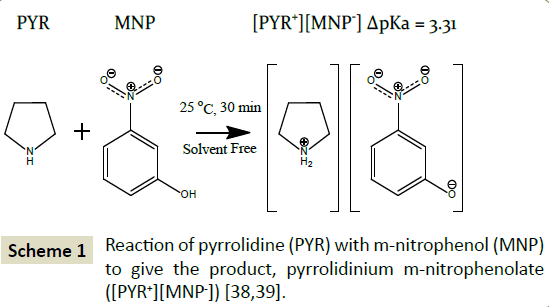
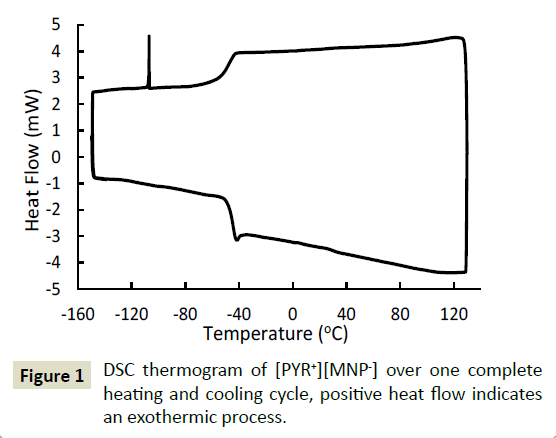

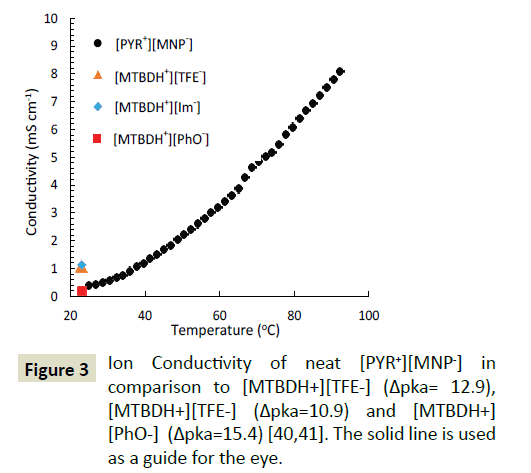

 (3)
(3)